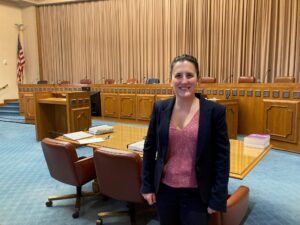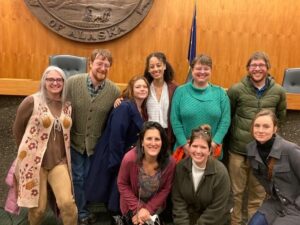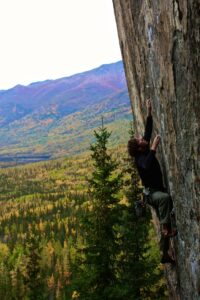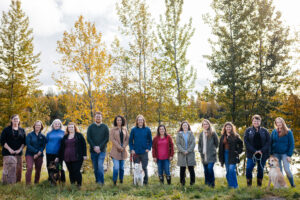
The twelve days of litigation
By Dawnell Smith
No matter how often we write the North Pole with a short wish list asking for more convenient court schedules and rulings that go our way, litigation just never happens that way. It also never happens in twelve days, but our winter schedule just got packed as tight as Santa’s sack of toys, so we thought we’d share our latest litigation lowdown with a Christmas carol everyone knows.
We even stuffed in a few legal terms and practices along the way.
On the first day of litigation
Our true love gave to us, Ninth Circuit Court arguments
This month we learned that oral argument in our appeal of a ruling allowing oil and gas operators to harass or injure polar bears in the Beaufort Sea will take place on Feb. 8 in Portland, Oregon. The timing feels like a polar bear hug: intimidating because it’s squeezed in among all our other competing deadlines, and also a exhilarating because we can show these animals some love in court.
Oh, but wait! We just learned this week that we also have another oral argument Feb. 5 in San Francisco on our appeal of a lower court ruling that allows ConocoPhillips to move forward with the Willow oil and gas project.
Even without grappling with crunch time during the holidays, preparing for oral argument requires attention from the entire legal team, so we’ll be busy all month so we can hit the ground running in 2024 like Santa’s reindeer seamlessly launching off a roof in the wee hours of Christmas Day.
On the second day of litigation
Our true love gave to us, two formal jackets
We’re talking business attire here. While our lawyers occasionally walk around the office in stocking feet or Extra Tuffs, they level up in court. The “two jackets” referred to here represent the two lawyers who argue our cases during oral argument.
In the courtroom, legal teams can include multiple lawyers representing more than one set of clients. In many of the cases we bring, including the oral argument in February, we have two attorneys at the table.

Bridget Psarianos, senior staff attorney with Trustees, in a Pasadena courtroom before oral argument. Photo by Dawnell Smith
One lawyer takes the lead. The other takes the role of “second chair.” While the lead attorney presents before the court, the other takes notes, confirms facts, pays attention to points made by the opposing legal team or questions asked by the judges, and then assists the arguing attorney with a response.
On the third day of litigation
Our true love gave to us, three judges a-grilling
In the appellate court, we mostly argue before a panel of three judges, who have a lot of questions. Our argument in February will take place before such a panel. The U.S. Ninth Circuit Court of Appeals is currently authorized for 29 judgeships, and the appeal panel will be randomly selected from that pool.
There’s an element of “luck of the draw” here because judges bring their own knowledge, perspectives, ideologies, biases, and judicial records to the room. Whoever is on the panel, they will certainly be grilling our attorneys for clarifications and explanations, revealing their line of thinking and where our argument resonates. After it’s over, the waiting game begins for a ruling.
Rarely, when an appellate court panel issues a decision, a party can request that a full panel of judges re-hear it, as happened in our Izembek lawsuit last year. We argued before 11 judges from the Ninth Circuit Court in Pasadena last December. The case was resolved outside of court when the Department of the Interior withdrew the land exchange at issue and requested that the court dismiss the case, which it did last June.
On the fourth day of litigation
Our true love gave to us, four briefing deadlines
Lawsuits require a schedule, so the court sets deadlines. There were four due dates related to our Willow lawsuit over the last month. The idea is that the court wants to hear from all parties before making a ruling.
The four recent deadlines were on two motions we filed–one in U.S. District Court and one in the U.S. Ninth Circuit Court of Appeals–requesting a pause on construction of the ConocoPhillips Willow project pending our appeal. (A November District Court ruling didn’t go our way, so we appealed; we also appealed in 2020 and won.)

Tracy always celebrates people and all they do to support our work. Here, on the left, she celebrates Lydia and Geoff passing the Alaska bar. Next to her: Geoff, Lydia, Vicki, Lang in back; Bridget, Rachel and Joanne in front. Dawnell taking the photo.
Both courts denied our request for a pause in construction, though the Dec. 18 Ninth Circuit Court ruling did not make any judgement on the merits of the case and expedited our appeal. Our appeal continues with briefing in late December into January, with oral argument on Feb. 5.
On the fifth day of litigation
Our true love gave to us, five monthly donors!
One of them could be you! ‘Tis the season for giving, after all, and we’re giving it all we’ve got in court. We’ve been doing it for 50 years precisely because of supporters committed to the health of Alaska’s lands, waters, wildlife, and communities for generations to come.
Since we’re going into our 50th year, our development director Tracy Lohman set a goal of Trustees having 50 monthly donors by the end of 2024. We invite you help us reach that goal and make it so.
Learn more from a few monthly donors who shared their stories about taking care of the places they love.
On the sixth day of litigation
Our true love gave to us, six plaintiffs a-standing
A party in a lawsuit must have standing or the right to challenge the conduct of another party in court.
In other words, those bringing a lawsuit must demonstrate they are the appropriate parties to do so and show an actual and imminent injury. As you might imagine, standing can get a little fuzzy in environmental law. Real and threatened injuries or harm due to pollution, toxins, the destruction of landscapes, and climate change can do systemic harm to entire ecosystems and the planet for generations to come. Who has standing with concerns of such scope and magnitude then?
The groups and people we represent would be directly impacted by projects like massive mines, the industrialization of sacred lands by oil and gas drilling, or agency decisions around hunting regulations on public lands. These clients include people who live in local communities that would be directly impacted by projects or decisions, groups that represent a region’s villages, or organizations with m

Caribou in the western Arctic don’t have standing because they’re animals, but local people and communities who are in relationship with caribou can have standing. Courtesy Protect The Arctic.
embers who care about certain places because of their interest in fishing, wildlife viewing, public health, recreation, and other reasons.
Take our Willow litigation, for example, which includes six plaintiffs with standing: Sovereign Iñupiat for a Living Arctic, Alaska Wilderness League, Northern Alaska Environmental Center, Environment America, Sierra Club and The Wilderness Society.
These groups have a direct interest in the health and future health of Alaska’s Arctic.
On the seventh day of litigation
Our true love gave to us, seven events a-coming
For a nonprofit law firm to thrive, it needs a lot of supporters, including client groups who bring their experience and passion, partner groups who align with the work and work side-by-side, and volunteer board members who keep the organization healthy—plus, convenings and parties to plan, make decisions, and celebrate.
Plus, you need one Ashley Boyd, our administrative director, who lends a hand in the coordination of all events. Sometimes this means food and venue planning for a board meeting and sometimes it means running big events with a lot of moving parts.
Since it’s our 50th anniversary in 2024, we’ll hold our usual two board meetings, a meet and greet, and a couple of fundraising events, plus a bomber concert in May and an outdoor barbeque birthday party in September. That’s seven events, not counting the extras we’ll conjure up in the coming days.
On the eighth day of litigation
Our true love gave to us, eight reporters a-calling
We can’t always predict exactly how many reporters will come calling, but we can absolutely say it takes both hands to juggle calls and emails when a court ruling comes out or we file a lawsuit.
The work we do has state, national and global impact relating to climate, biodiversity, and how communities, Tribes and the public can engage in the decisions impacting them. When we first went to court over the Willow project, we could hardly get a reporter interested in it. The next time around, the response was epic, and we did interviews with reporters in South America, Europe, Africa, and around the country and state.
Climate change concerns and climate action advocacy has put our Arctic work in the spotlight, which means the Arctic legal team—Brook Brisson, Suzanne Bostrom, and Bridget Psarianos—have been doing background interviews with reporters for years.
Everyone at Trustees has a role in clearly explaining what’s going on and why, and we’re deeply grateful for our relationships with reporters and for all their efforts to convey the facts and explain what’s at stake.
On the ninth day of litigation
Our true love gave to us, nine error messages

Lang on a rock. Photo by Summer Holt
When we “we just went to court” because we filed a lawsuit, an appeal, or a motion, we’re not going to the courthouse anymore. We’re going online where lawsuits get filed these days.
Everyone knows what that means: Glitches, error messages, and anxious attorneys in Lang Van Dommelen’s office as he (our legal assistant) steadily plays the game of “evade the wheel of doom.” Sometimes, just to make it fun, there’s an “update” to the court filing system that causes all kinds of havoc.
Lang gets it done every time. It helps that he climbs rocks and skis in the backcountry for regular doses of nature and adrenaline, because online distress seems like child’s play to him.
On the tenth day of litigation
Our true love gave to us, ten years a’Pebbling
In November, attorneys Rachel Briggs and Siobhan McIntyre (and me, Dawnell) went to Dillingham for the United Tribes of Bristol Bay’s 10th Anniversary Celebration that shined a light on current protections for Bristol Bay and all the people who have helped stop the proposed Pebble mine. The event honored all those in the Bristol Bay region and beyond who have put so much energy and passion into protecting Bristol Bay communities, fisheries, livelihoods, and ways of life.
Just to keep you up to date, the State of Alaska asked the U.S. Supreme Court to hear the State’s challenge to the U.S. Environmental Protection Agency’s decision to protect Bristol Bay. We’re waiting for the Supreme Court to decide whether it will take the case and are ready to support Bristol Bay’s communities and fight the proposed Pebble mine as we have for nearly 20 year.
On the eleventh day of litigation
Our true love gave to us, eleven declarations
A declaration is perhaps first and foremost a story—a true one—about a person’s or group’s interest in the issues addressed in a lawsuit. The declaration is the story a person or group presents to the judge. It is also a document in which a person or group swears, under penalty of perjury, that the statement is true and correct.
Our legal fellows Lydia Heye and Geoff Toy have interviewed, put into writing, and confirmed declarations for a range of people and groups in our Arctic lawsuits. Lydia once described this part of her job as her favorite because it means talking to real people about real impacts and concerns.
On the twelfth day of litigation
Our true love gave to us, 12 months a-looming

Staff in the fall of 2023 in Anchorage, Alaska. Photo by Jovell Renny
The number of cases looming is inevitably in flux, because some cases are active in court with briefing schedules and court dates. Ohers are “pending” because all parties agreed to a pause while an administrative process gets done and a decision gets made. And a few are in the making, because we know they are coming and we’re ready for them, but we’re waiting for the inflection point that prompts us to go to court.
Yep, with the end of 2023 comes the beginning of 2024—another 12 months of carrying cases forward and leaning into new ones. Another 12 months of implementing budget and legal plans under the guidance of Vicki Clark and Teresa Clemmer, our executive and legal directors.
Sometimes this work can feel like a whole lot of Grinch and not enough sugar plums, but that’s just the weight of what’s at stake. Truth is, the community within which we work and work alongside brings care and joy to the world, and for that we are grateful.
Altogether now…


